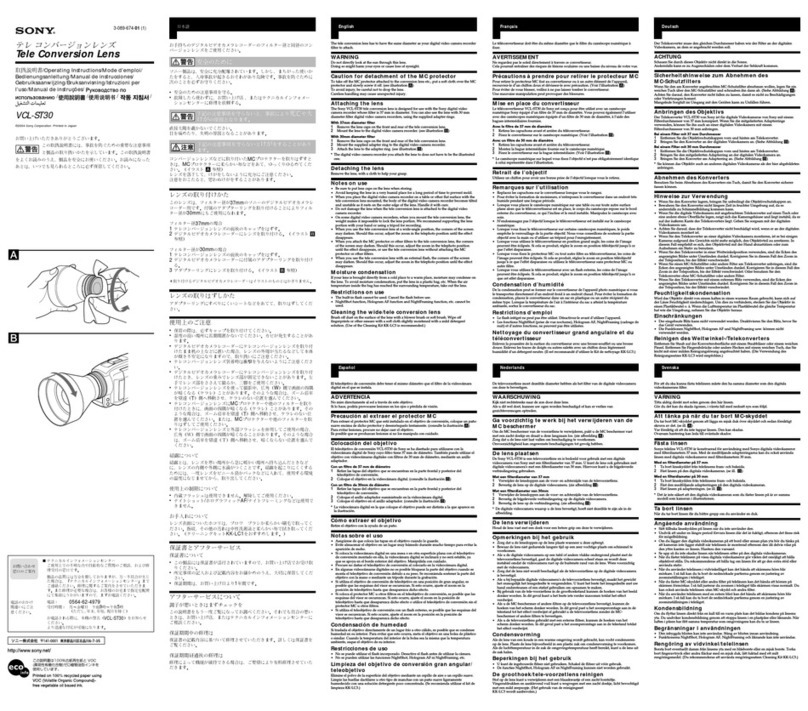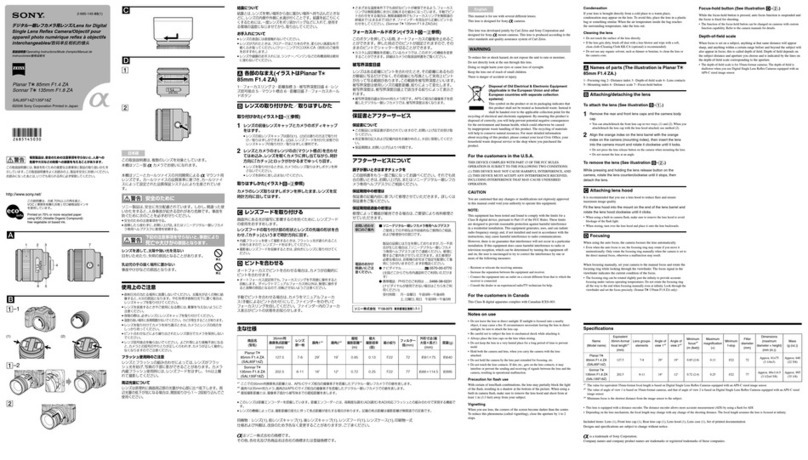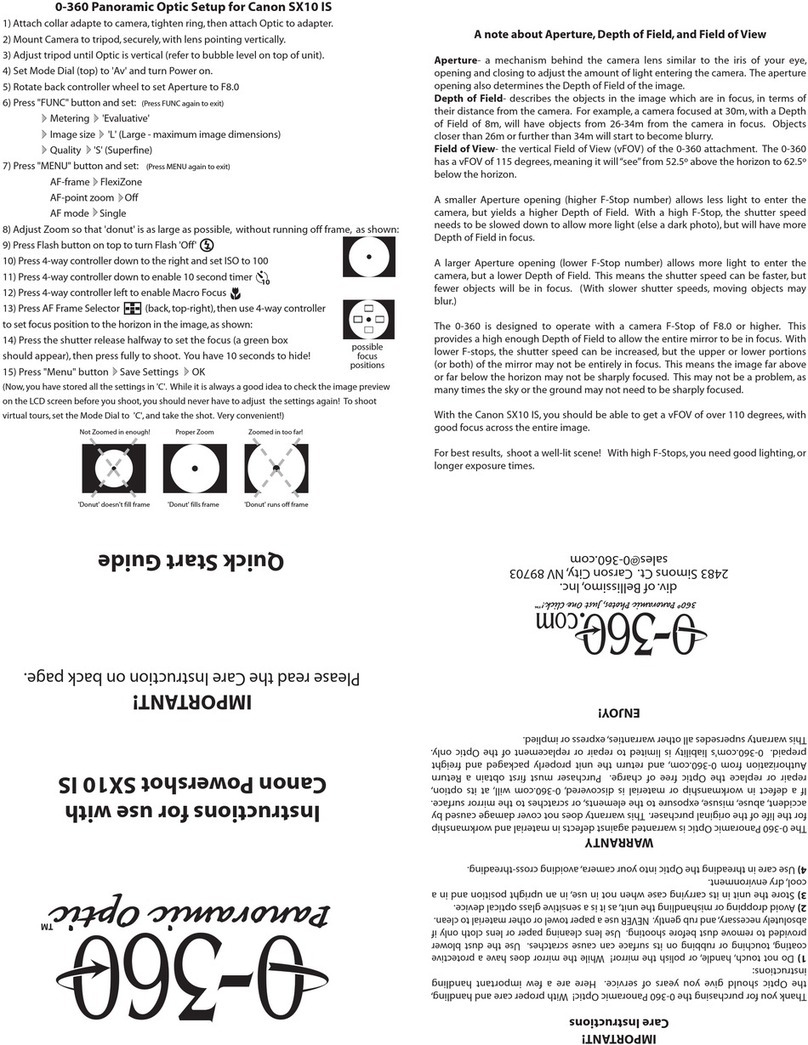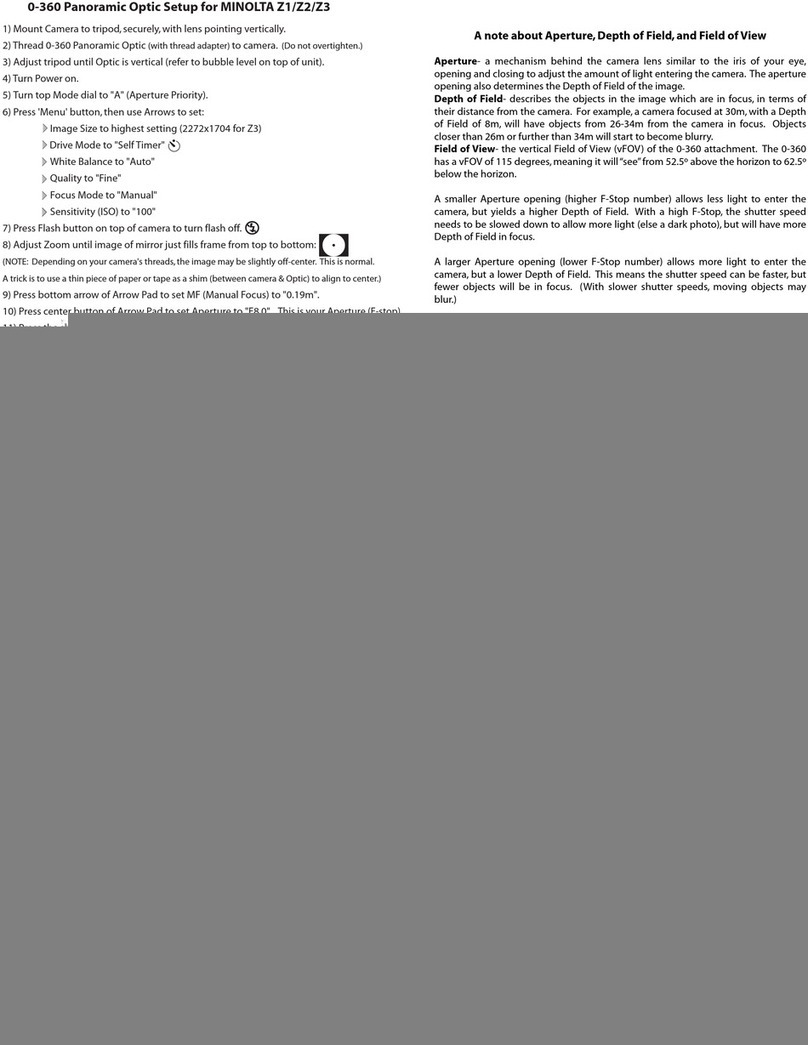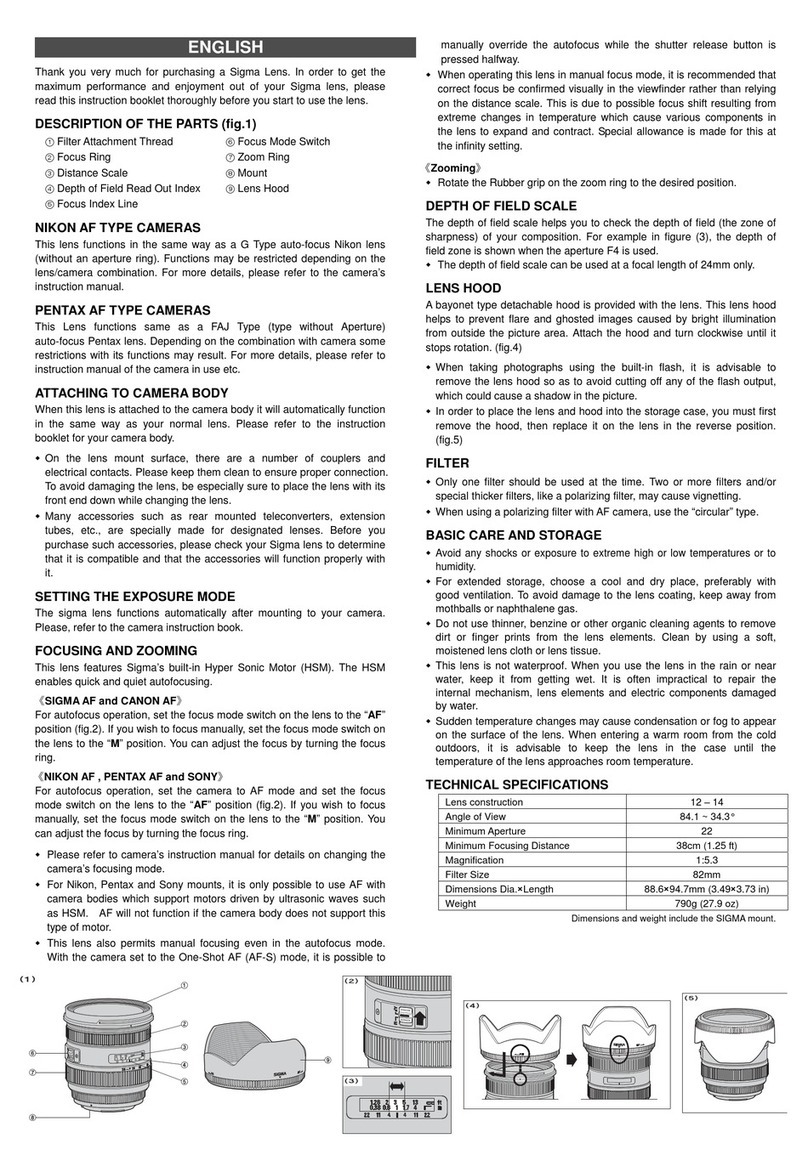
A note about Aperture, Depth of Field, and Field of View
Aperture- a mechanism behind the camera lens similar to the iris of your eye,
opening and closing to adjust the amount of light entering the camera. The aperture
opening also determines the Depth of Field of the image.
Depth of Field- describes the objects in the image which are in focus, in terms of
their distance from the camera. For example, a camera focused at 30m, with a Depth
of Field of 8m, will have objects from 26-34m from the camera in focus. Objects
closer than 26m or further than 34m will start to become blurry.
Field of View- the vertical Field of View (vFOV) of the 0-360 attachment. The 0-360
has a vFOV of 115 degrees, meaning it will“see” from 52.5º above the horizon to 62.5º
below the horizon.
A smaller Aperture opening (higher F-Stop number) allows less light to enter the
camera, but yields a higher Depth of Field. With a high F-Stop, the shutter speed
needs to be slowed down to allow more light (else a dark photo), but will have more
Depth of Field in focus.
A larger Aperture opening (lower F-Stop number) allows more light to enter the
camera, but a lower Depth of Field. This means the shutter speed can be faster, but
fewer objects will be in focus. (With slower shutter speeds, moving objects may
blur.)
The 0-360 is designed to operate with a camera F-Stop of F8.0 or higher (preferably
9, 10, or 11). This provides a high enough Depth of Field to allow the entire mirror to
be in focus. With lower F-stops, the shutter speed can be increased, but the upper or
lower portions (or both) of the mirror may not be entirely in focus. This means the
image far above or far below the horizon may not be sharply focused. This may not
be a problem, as many times the sky or the ground may not need to be sharply
focused.
With the Olympus E10 or E20, you should be able to get a vFOV of over 110 degrees,
with good focus across the entire image.
For best results, shoot a well-lit scene! With high F-Stops, you need good lighting, or
longer exposure times.
0-360 Panoramic Optic Setup for Olympus Camedia E-10/20
1) Mount Camera to tripod, securely, with lens pointing vertically.
2) NOTE:It is highly recommended that you attach a UV filter to the front of your lens
before continuing. This will help protect the lens from scratching while attaching the Optic.
3) Thread 0-360 Panoramic Optic to camera. (Do not overtighten.)
4) Adjust tripod until Optic is vertical (refer to bubble level on top of Optic).
5) Turn Power on.
6) Rotate Mode Dial to Mode "A" (Aperture Priority).
7) Rotate either Main Dial or Sub Dial to set Aperture to F8 or higher (preferably 11).
8) Set Image Quality ( ) to "SHQ" at highest dimensions, or "TIFF".
9) Set Metering to ESP.
9) Turn Flash off.
10) Turn Timer on.
11) Set to Manual Focus.
12) Rotate the Focus Ring all the way to "NEAR".
13) Adjust Zoom until image of mirror just fills frame. (NOTE: Depending on your camera's
threads, the image may be slightly off-center. This is normal. A trick is to use a thin piece of paper
or tape as a shim to align to center.)
14) Now, rotate the Focus Ring towards "FAR" slowly, and listen closely for 4-6 ticks of the
motorized lens. The focus slider shown in the Info bar of the monitor will not move.
15) Close the Eyepiece Shutter.
14) Press the shutter release. You have 10 seconds to hide!
15) Advanced Users: To adjust exposures,use Manual setting,instead of Aperture
Priority. Keep the Aperture at F8.0++, but experiment with the exposure times. Also
experiment with Sharpness, Contrast, Metering, ISO and other advanced features.
div. of Bellissimo, Inc.
2483 Simons Ct. Carson City, NV 89703
Instructions for use with
Olympus Camedia E-10/20
IMPORTANT!
Please read the Care Instructions on back page.
Quick Start Guide
IMPORTANT!
Care Instructions
Thank you for purchasing the 0-360 Panoramic Optic! With proper care and handling,
the Optic should give you years of service. Here are a few important handling
instructions:
1)
Do not touch, handle, or polish the mirror! While the mirror does have a protective
coating, touching or rubbing on its surface can cause scratches. Use the dust blower
provided to remove dust before shooting. Use lens cleaning paper or lens cloth only if
absolutely necessary, and rub gently. NEVER use a paper towel or other material to clean.
2) Avoid dropping or mishandling the unit, as it is a sensitive glass optical device.
3) Store the unit in its carrying case when not in use, in an upright position and in a
cool, dry environment.
4) Use care in threading the Optic into your camera, avoiding cross-threading.
WARRANTY
The 0-360 Panoramic Optic is warranted against defects in material and workmanship
for a period of one year from date of purchase. This warranty does not cover damage
caused by accident, abuse, misuse, exposure to the elements, or scratches to the
mirror surface. If a defect in workmanship or material is discovered, 0-360.com will, at
its option, repair or replace the Optic free of charge. Purchaser must first obtain a
Return Authorization from 0-360.com, and return the unit properly packaged and
freight prepaid. 0-360.com's liability is limited to repair or replacement of the Optic
only. This warranty supersedes all other warranties, express or implied.
ENJOY!
TM
Not Zoomed in enough! Proper Zoom Zoomed in too far!
'Donut' doesn't fill frame 'Donut' fills frame Donut runs off frame

